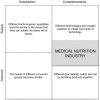Food-pharma convergence in medical nutrition- best of both worlds?
- PMID: 24358214
- PMCID: PMC3865102
- DOI: 10.1371/journal.pone.0082609
Food-pharma convergence in medical nutrition- best of both worlds?
Abstract
At present, industries within the health and life science sector are moving towards one another resulting in new industries such as the medical nutrition industry. Medical nutrition products are specific nutritional compositions for intervention in disease progression and symptom alleviation. Industry convergence, described as the blurring of boundaries between industries, plays a crucial role in the shaping of new markets and industries. Assuming that the medical nutrition industry has emerged from the convergence between the food and pharma industries, it is crucial to research how and which distinct industry domains have contributed to establish this relatively new industry. The first two stages of industry convergence (knowledge diffusion and consolidation) are measured by means of patent analysis. First, the extent of knowledge diffusion within the medical nutrition industry is graphed in a patent citation interrelations network. Subsequently the consolidation based on technological convergence is determined by means of patent co-classification. Furthermore, the medical nutrition core domain and technology interrelations are measured by means of a cross impact analysis. This study proves that the medical nutrition industry is a result of food and pharma convergence. It is therefore crucial for medical nutrition companies to effectively monitor technological developments within as well as across industry boundaries. This study further reveals that although the medical nutrition industry's core technology domain is food, technological development is mainly driven by pharmaceutical/pharmacological technologies Additionally, the results indicate that the industry has surpassed the knowledge diffusion stage of convergence, and is currently in the consolidation phase of industry convergence. Nevertheless, while the medical nutrition can be classified as an industry in an advanced phase of convergence, one cannot predict that the pharma and food industry segments will completely converge or whether the medical industry will become an individual successful industry.
Conflict of interest statement
Figures









Similar articles
-
Diffusion, convergence and influence of pharmaceutical innovations: a comparative study of Chinese and U.S. patents.Global Health. 2018 Aug 30;14(1):92. doi: 10.1186/s12992-018-0408-z. Global Health. 2018. PMID: 30165885 Free PMC article.
-
Guidelines, editors, pharma and the biological paradigm shift.Mens Sana Monogr. 2007 Jan;5(1):27-30. doi: 10.4103/0973-1229.32176. Mens Sana Monogr. 2007. PMID: 22058616 Free PMC article.
-
How should we support pharmaceutical innovation?Expert Rev Pharmacoecon Outcomes Res. 2009 Aug;9(4):313-20. doi: 10.1586/erp.09.34. Expert Rev Pharmacoecon Outcomes Res. 2009. PMID: 19670991
-
Medications development for substance-use disorders: contextual influences (dis)incentivizing pharmaceutical-industry positioning.Expert Opin Drug Discov. 2014 Nov;9(11):1265-79. doi: 10.1517/17460441.2014.951631. Epub 2014 Aug 27. Expert Opin Drug Discov. 2014. PMID: 25162124 Review.
-
Scientific, economic, regulatory, and ethical challenges of bringing science-based pediatric nutrition products to the U.S. market and ensuring their availability for patients.JPEN J Parenter Enteral Nutr. 2014 Nov;38(2 Suppl):17S-34S. doi: 10.1177/0148607114549771. Epub 2014 Sep 23. JPEN J Parenter Enteral Nutr. 2014. PMID: 25249029 Review.
Cited by
-
The Co-Evolution of Markets and Regulation in the Japanese Functional Food Industry: Balancing Risk and Benefit.Foods. 2025 Apr 30;14(9):1581. doi: 10.3390/foods14091581. Foods. 2025. PMID: 40361663 Free PMC article. Review.
-
Cost-benefit relation of diet and probiotics in iatrogenic bowel irregularity (IBI).Front Pharmacol. 2014 Feb 17;5:14. doi: 10.3389/fphar.2014.00014. eCollection 2014. Front Pharmacol. 2014. PMID: 24596557 Free PMC article. No abstract available.
-
Identification of Flavonoids, Antioxidant and Antiproliferative Activity of Aqueous Infusions of Calendula officinalis L., Chelidonium majus L., Teucrium chamaedrys L. and Alchemilla vulgaris L.Food Technol Biotechnol. 2024 Mar;62(1):49-58. doi: 10.17113/ftb.62.01.24.8175. Food Technol Biotechnol. 2024. PMID: 38601959 Free PMC article.
-
Explaining Consumer Intentions for Foods with Antioxidant Properties: Predictors of Choice and Purchase Barriers.Int J Food Sci. 2021 Jul 12;2021:9971425. doi: 10.1155/2021/9971425. eCollection 2021. Int J Food Sci. 2021. PMID: 34336998 Free PMC article.
References
-
- Eussen SR, Verhagen H, Klungel OH, Garssen J, van Loveren H, et al. (2011) Functional foods and dietary supplements: products at the interface between pharma and nutrition. European Journal of Pharmacology 668 Suppl 1S2–9. - PubMed
-
- Phyllis Balch A (2010) Prescription for Nutritional Healing: Penguin Group (USA) Incorporated.
-
- Henry CJ (2010) Functional foods. Eur J Clin Nutr 64: 657–659. - PubMed
-
- Howlett J (2008) Functional Foods From Science to Health and Claims. ILSI Eur Concise Monogr: 1–36.
-
- van Kreijl CF, Knaap AGAC, van Raaij JMA (2006) Our food, our health: healthy diet and safe food in the Netherlands. 189–213.
MeSH terms
LinkOut - more resources
Full Text Sources
Other Literature Sources

